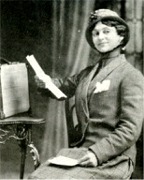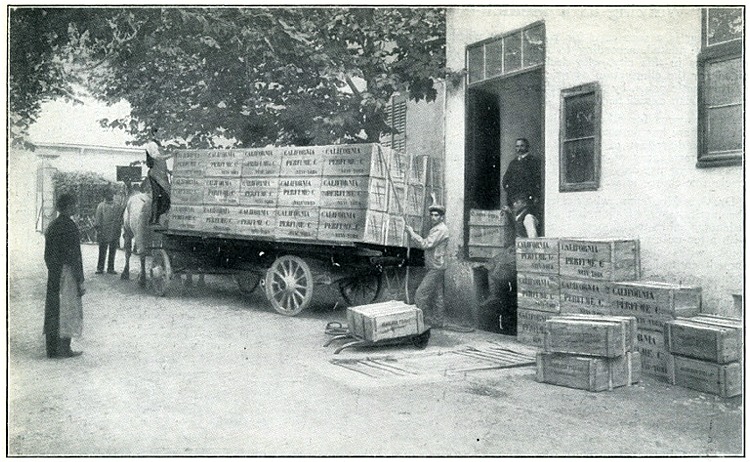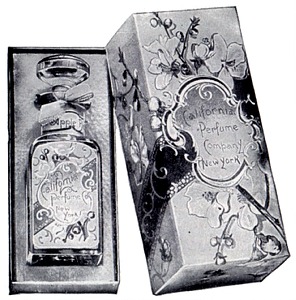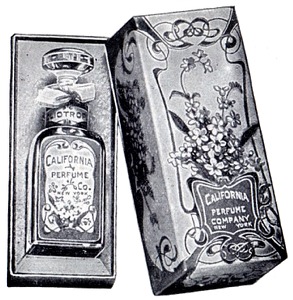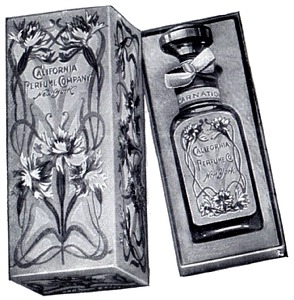Pomade Shipment From Cannes
|
This photograph was taken recently at Cannes, and shows a shipment of Pomades direct from the flower fields of France to our laboratory. The value of this one shipment is over Twelve Thousand Dollars. We receive such shipments regularly. Have you ever taken the time to read those pages (6 to 9) of the C P C BOOK telling about the manufacture of C P C Perfumes from the flower fields to the finished products? If not, it will pay you to do so. By familiarizing yourself with the process of perfume making, you will be able to talk about C P C Perfumes more intelligently, more entertainingly and more convincingly, and that means more orders and larger profits. C P C perfumes are different. Find out why and if you can demonstrate that difference to your trade it is easy to book orders. C P C perfumes are more fragrant, more lasting and fixed than the common kind. Illustrations like the above photograph and the article on Perfumes in the C P C BOOK give you the reason why. Tell it to your customers. From the March 1913 CPC Outlook |
|
Following are pages 6 through 8 of the 1913 C P C Book (page 9 is the fragrance listing):
Perfumes The CPC Perfumes represent the standard of excellence in perfume manufacture. They have gained this high reputation because they are natural floral odors, extracted from the actual flowers and blossoms, and are therefore true to label. There are two distinct kinds of perfumes, viz. floral and chemical. In other words, natural and artificial. Chemical or artificial perfumes are made entirely of chemicals, oils and tinctures, and substitutes are thus produced which are similar to the odors given to the flowers by nature. But chemical perfumery never has the rich, perfect fragrance of the natural floral extracts. Furthermore, the odor of the chemical perfume evaporates far more quickly than that which is produced from the flowers themselves. As previously stated, CP C perfumes are natural floral odors; and in order that you may understand all that this term implies, we will briefly describe the actual process of extracting the perfume from the flowers.
The flowers are gathered in large quantities and are put into enormous vats filled with hot grease. This grease is allowed to cool, and this cooling process absorbs every particle of odor from the flowers. It is then warmed sufficiently to allow it to be strained or filtered and the leaves of the flowers are taken out. Thus the fragrance of the flowers has become an intrinsic part of the grease. In this form it is called pomade. It is put up in cans and shipped from the flower fields to our laboratory at Suffern, N. Y. The pomade is then put in large "washers" with certified high proof spirits. The pomade and spirits are thoroughly mixed by machinery in these washers until the spirits extract all the odor from the grease. This process the perfumer calls washing. The mixture of spirits and grease is now put through a freezing process, being reduced to a temperature much below the freezing point. The grease particles freeze and are easily taken out, while the high proof spirits, of course, never freeze. The grease is now practically odorless, while the spirits are thoroughly impregnated with the odor of the flowers.
These "washings" form the base of the various perfumes. The art of the perfumer is now needed to properly blend and fix the odors, to make them distinctive and lasting. We desire to mention right here that our head chemist is recognized as one of the most skilled in the perfume art. He has had an experience in Europe and America of thirty-five years. There are no finer perfumes made anywhere than those bearing the California Perfume Company label. They are highly concentrated and lasting, yet containing all the delicacy and sweetness that nature has put into its flowers and blossoms. Each odor possesses its own peculiar fragrance. Many women choose a particular odor which is especially pleasing and adopt it as their own. The continued use of a favorite perfume gives a woman a certain distinctive charm of individuality. This, however is only possible where a really good perfume is used. From the 1913 C P C Book Other Articles Related to the Manufacture of CPC Perfumes: |

